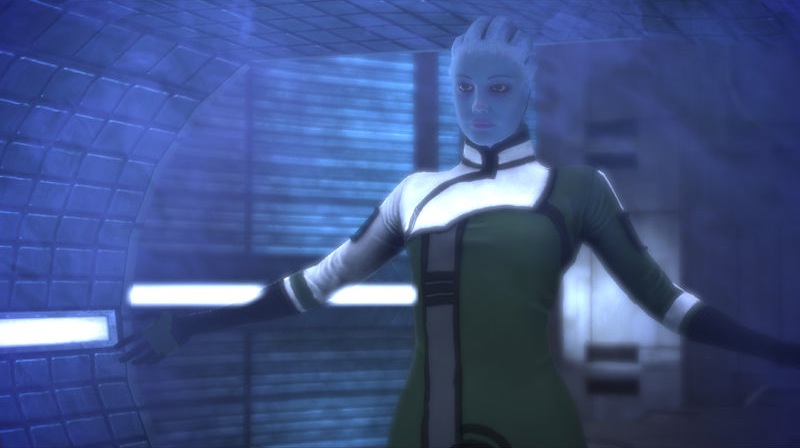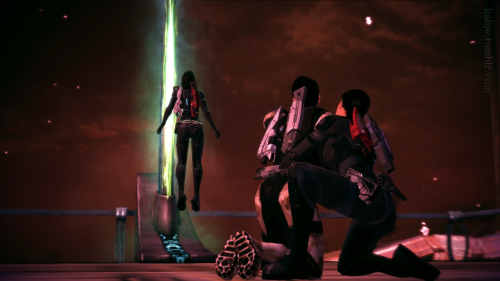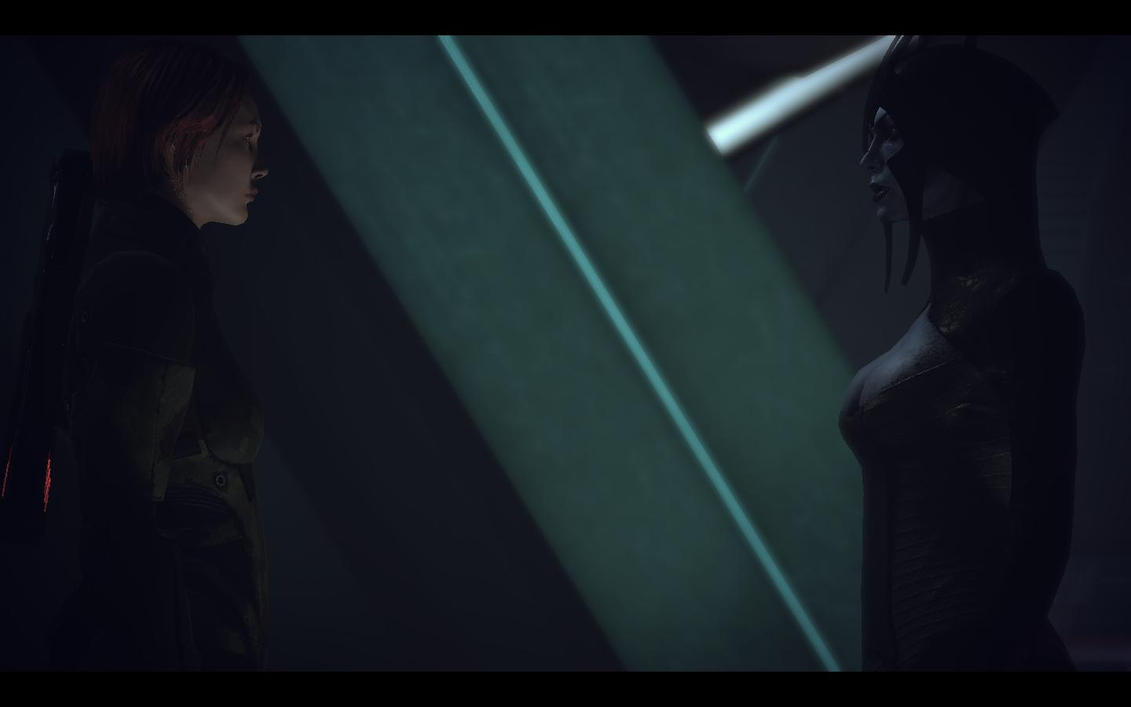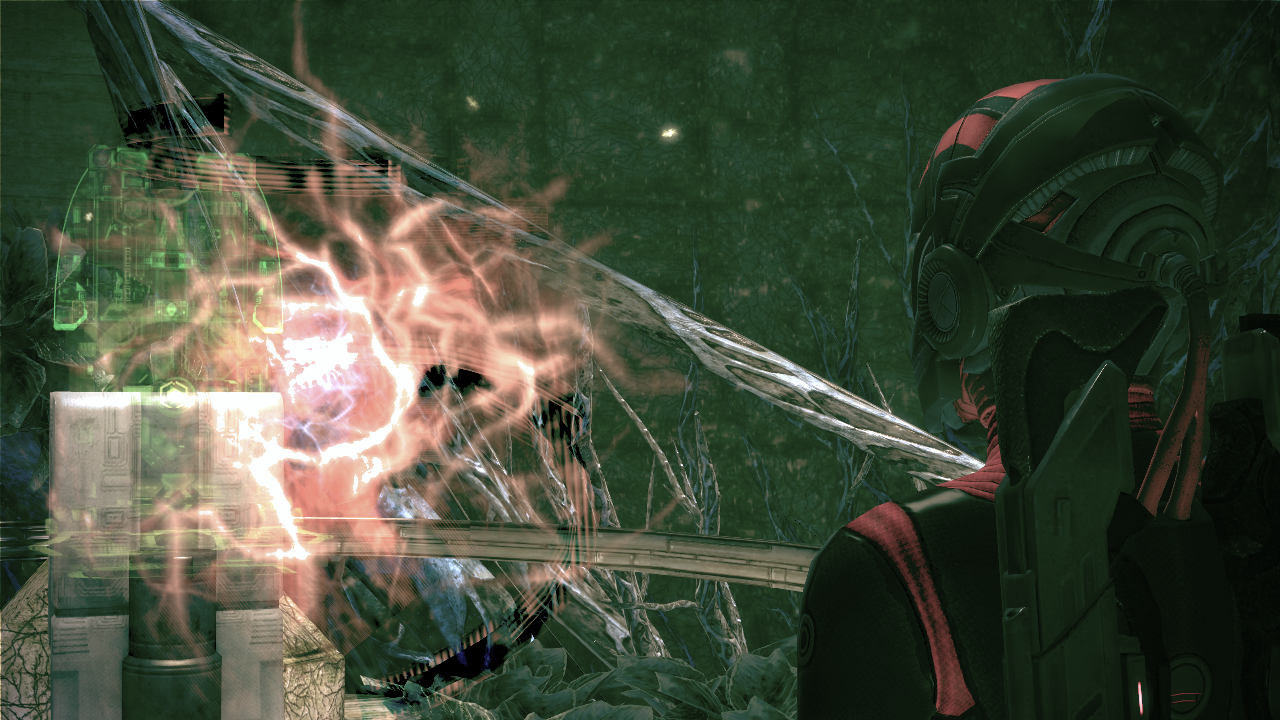Yo.
As promised, I’m going to analyze the main plot of the game before boring down to the specific episodes. This will also serve as a poor man’s synopsis of the story. I’ll try to restrain myself from lacing the analysis with fanboy love, but no promises.
Let’s do this by the numbers, shall we?
1
The player hits “new game” and things get rolling. There’s a brief crawl of text that establishes the world, although much of what it states can be inferred from the dialog and so on: it’s the future, and mankind has finally achieved faster-than-light travel (FTL), but they now find themselves the underdogs in a universe populated by multiple alien species, some friendly, some hostile and some indifferent.
But before we get to the “real plot,” I think the One actually begins earlier, with the player’s construction of Commander Shepard.
Mass Effect, like most western RPGs before and after it, contains a detailed character customization system. You, the player, can make Shepard male or female, white or black or asian, etc. Unlike many RPGs, though, you are also given rudimentary control over Shepard’s backstory. The small choices you make during this creation process hold only a little relevance to the story, but it’s enough. The crafting of your Commander Shepard is an important part of the game and it helps compose the One.
By the way, for the duration of this series I’ll probably refer to Shepard as a “she,” since the character is generally considered to be more interesting when female. This is most likely due to the prowess of Jennifer Hale, the voice actress. I have nothing against the voice actor for male Shepard, Mark Meer — he’s quite hilarious whenever he isn’t playing Shepard — but I’ve played this game a ridiculous number of times, and the most fun I’ve ever had was when I played as a woman.

Back on topic:
The One continues when we see Shepard aboard the SSV Normandy, an Alliance spaceship, where she is serving as Executive Officer to Captain Anderson. There’s little left in this One, just some character introductions.
2
Shepard is called into the debriefing room to meet with Captain Anderson and an alien named Nihlus, who has come aboard to observe her and build an estimate of her abilities. If he finds her worthy, he’ll recommend her for the position of Spectre, which would make her a sort of intergalactic James Bond.
The Normandy is about to land on a planet named Eden Prime, where a human colony has discovered a powerful artifact called a Prothean Beacon. Anderson and his crew are here to move the Beacon off-world to the Citadel, where more capable alien scientists can inspect it and learn its secrets. Shepard is told she and Nihlus will drop down to find the Beacon and bring it aboard.
The real trouble begins, though, when the Normandy receives a distress call from the planet and a video message. This creature is briefly seen in the message:

Nobody knows it yet, but that thing is one of the Reapers, a species of giant, sentient spaceships. As will be discovered much later, the Reapers are going to serve as the primary antagonists not only to Mass Effect 1, but the whole trilogy. For now, though, this nameless monstrosity is nothing more than a strange spaceship causing destruction on Eden Prime.
Shepard, her squad and Nihlus land on Eden Prime and head for the Beacon.
3
The mission basically goes wrong and a few things happen, most notably the murder of Nihlus, who is betrayed by a fellow turian Spectre, Saren. We’ll get to him in a bit.
The true Three moment occurs when Shepard finally locates the Prothean Beacon. With all hostiles down, she hails the Normandy and asks for a pickup. Despite earlier setbacks, the mission looks like it will be a success.
But one of Shepard’s two squadmates makes the mistake of approaching the Beacon when it starts pulsating and is soon being sucked toward it. Shepard reacts quickly and saves her squadmate, but ends up enthralled by the Beacon’s power herself. She receives a distorted vision of the Prothean people being wiped out, goes unconscious, and the Beacon explodes.
So, critical mission failure, then.
Shepard’s Prothean visions play a huge role in dictating the course of the story, and better still, they give the player character a good reason to wield incredible power and meddle in the affairs of others. Her visions are vague and unhelpful right now, but they will become crystal clear by the Six.
4
 Captain Anderson brings Shepard to the Citadel Council, hoping to convince them to arrest Saren for his betrayal, or at the very least revoke his Spectre status.
Captain Anderson brings Shepard to the Citadel Council, hoping to convince them to arrest Saren for his betrayal, or at the very least revoke his Spectre status.
They do neither, pointing out that the heroes have no evidence against Saren, so the remainder of the Four is spent searching the Citadel for proof.
Because the game opens up a bit here with side quests and shortcuts, the length of the Four is player dependent. It can pass in thirty minutes, two hours or even six, whatever.
In standard Four fashion, the entirety of this little adventure is spent playing the underdog against authority and struggling with a seemingly untouchable enemy, plus acquiring new squadmates. Eventually Shepard finds the proof she needs to out Saren, who flees into space to continue his nefarious deeds without the Council’s support. She is rewarded for her hard work by becoming mankind’s first Spectre and sent after Saren to capture or kill him.
Switch
Technically the Switch occurs when Shepard becomes a Spectre, but the best moment happens a scene or two later, when Captain Anderson relinquishes control of the Normandy to her. Once aboard her first ship, Shepard gives a speech to her new crew, affirming her role as a leader and an agent of galactic justice. It’s a stirring moment, and from this point forward the scope of the game increases tenfold: with the Normandy Shepard can scour the galaxy at the player’s whim and visit planets charted and uncharted alike, and her task demands she investigate suspicious activity on three separate worlds.
If Mass Effect were a movie, this Switch would probably occur halfway through, with the remainder of the running time spent tracking down Saren using one or two of the leads suggested by Captain Anderson.
But this isn’t a movie, and fans know this Switch doesn’t occur halfway through the game — in fact, this is just when the game starts to properly begin. Everything before Shepard’s promotion to Spectre is more or less setup, which means that the majority of Mass Effect is spent in the Five.
This would be very unusual in a film or a book, naturally, because the Switch is traditionally the major turning point for the main character(s). The same is true here: once Shepard becomes a Spectre, she barely develops as a character for the rest of the Five, like many stories. The only difference with ME is one of length and content.
Most stories have brief Fives, some have large Fives, but ME has a twelve hour Five.
I wonder if many RPGs are like this? I certainly think most Bioware RPGs are. Anyway . . .
5
As I said, most of the game fits here. Even if the player ignores all of the side quests and simply rushes through the plot, they will still spend the majority of their playtime here.
Shepard is given three leads to follow, and the player can pick whichever one they want and finish them in any order:
The Noveria Lead: Saren has an accomplice, Matriarch Benezia, an ancient asari with prodigious power and influence. She has isolated herself somewhere on the cold, corporate planet Noveria, and Shepard is advised to find and interrogate her.
The Therum Lead: In turn, Matriarch Benezia has a daughter, Liara T’Soni, who is excavating a Prothean ruin on the hostile planet Therum. Shepard is advised to find and interrogate her, too, but she’ll end up finding a willing ally in her instead.
The Feros Lead: Saren has joined forces with the geth, a nearly limitless army of robots that attacked Eden Prime. Now they’ve been sighted on Feros, another struggling human colony, and Shepard is advised to save the colony and discover how and why Saren has ordered the Geth to attack them.
In addition to these, once Shepard has visited at least two of any of these worlds and solved their respective problems, the Council notifies her of a fourth lead on Virmire: a squadron of salarian agents have been tracking Saren’s movements and seem to have located his whereabouts on the beautiful planet Virmire, but their comms have gone dark and it’s apparent they’re in trouble. Shepard is advised to visit them at some point and learn what they’ve found.
Each of these four leads have an Enneagram of their own (with the possible exception of Therum), so I won’t spend any more time on them other than is required to address the Six.
6
At the end of the Virmire mission a clear Six occurs, but in truth, all of the divergent missions possess a potential Six. Without going into too much detail, I’ll run through them one by one:

On Feros, Shepard eventually meets the asari Shiala, who once worked for Saren and has some limited knowledge of his plans. She knows Shepard received a confusing vision from the Beacon on Eden Prime because Saren did as well, and she gave him the Cipher so he could understand it. She wants to atone, so she also gives the Cipher to Shepard, which allows her to speak the Prothean language and comprehend their various cultures.
This can work as a Six because in the Three, Shepard received the vision but couldn’t understand it — now she can (to a certain extent).
On Noveria, Shepard confronts Matriarch Benezia (another asari, by the way), who explains a little bit more of Saren’s scheme, saying he’s heading for the Mu Relay. Benezia gives Shepard the coordinates to said Relay before succumbing to mind control-overdosing and bullet wounds.
While learning of the Mu Relay’s location is another critical chunk of information, it is the weakest out of the four potential Sixes, which is a shame, because the rest of the mission is heavy with drama and obvious late-story exposition. It can work, but it has no direct parallel with the Three.

On Therum, Shepard finds Dr. Liara T’Soni, Benezia’s daughter, suspended in mid-air by some faulty Prothean tech inside an archaeological dig site. When she is freed and brought aboard the Normandy, Liara uses her alien powers to share Shepard’s mind and witness the vision for herself, and she uses her own knowledge of the Protheans to understand it. (Yep, another Six with an asari. Last one, I promise.)
This is a decent Six: the similarities between Shepard and Liara held in a crucified position by Prothean technology is evident, and both the Three and the Six occur in Prothean dig sites, another swell connection. Also: with this Six the Beacon is uncovered by archaeology and understood with archaeology. So, lots and lots of parallels.
But the chances of players seeking out Liara last are infinitesimal, and the build-up to this Six is weak, so there’s a better option.

On Virmire, Shepard infiltrates Saren’s secret lab and discovers a second Prothean Beacon, which she promptly activates. Unlike the last time she did this, the Beacon doesn’t explode, and she receives a complementary vision that fills in the missing pieces from her original one.
In another case of things coming full-circle, just after this Shepard is contacted by Sovereign, Saren’s spaceship, which reveals itself to be a Reaper. It casually threatens her and all existence in a droning cadence, finally giving a voice and face to the game’s true villain. Saren is only a pawn — this guy, this thing, is the real threat.
This is the best Six for three simple reasons: Shepard finds another Beacon, which is a direct parallel to the Three; she encounters Sovereign for the second time, another direct parallel; and this mission is the most likely mission to be played last. When I first played ME I certainly saved Virmire for last, and based on my experience with Mass Effect Let’s Plays, so did most people.
It was a pretty risky move by Bioware to let the player choose which Sixes are false and which one is real, but I think it paid off. Once again, I must wonder if other RPGs share this pattern.
7
Whichever Six the player chose, the eventual outcome is the same: Shepard learns that Saren has passed through the Mu Relay to find the planet Illos, where he plans to use a mysterious and dangerous weapon called the Conduit. The Normandy flies back to the Citadel to update the Council and ask them for support in stopping Saren.
Unfortunately, the Council seems to lack a backbone: because Illos is outside of Council Space in the Terminus Systems, they fear sending a fleet there will start an intergalactic war. Shepard points out that the Normandy is outfitted with an advanced stealth engine capable of escaping detection in the Terminus, but she’s still overruled, and worse, the Council puts the Normandy under lockdown.
In true Seven fashion, Shepard has a moment of despair that is subsequently nullified by the comfort of one of her squadmates, and then Captain Anderson suggests she steal the Normandy. This is the core Seven moment: Shepard risks becoming an outlaw so she can follow Saren and stop him.
You’ll notice that this is Shepard’s decision, not the player’s, who is railroaded into following the story. That’s not a bad thing, at least not here, but it’s interesting to note that the player is not given full control over every number in the Enneagram.
8
The Eight is long, which makes sense considering this is an action RPG. Still. Long.
Once Shepard has fled the Citadel you’re free to fly around the galaxy and finish up any side quests you want, but inevitably you’ll head for the Mu Relay.
The Normandy drops Shepard and her squad on Illos, where they struggle for a while fighting Saren’s geth army inside the ruins of a Prothean city. Later they are contacted by a strange signal and follow it to meet an ancient virtual intelligence called Vigil.
There is a lull in the action for Vigil to communicate with Shepard and answer any questions the player has, explaining that the Conduit is a miniature Mass Relay capable of teleporting anyone straight to the Citadel, bypassing the space station’s security. Saren is going to use the Conduit to sneak up on the Citadel, infiltrate it, then take control of its hidden code to open a gateway to the thousands of Reapers lying dormant in dark space.
The Reapers would effectively invade the galaxy from the inside out.
Obviously, this would be bad, so Vigil gives Shepard a means of overriding Saren’s control and sends her to the Conduit.
The conversation with Vigil is a prime example of what I call an “Exposition Climax,” and it gives the player a chance to breathe while also delivering important information under a banner of tension.
Shepard chases Saren into the Conduit and arrives on the Citadel, where another series of firefights occur both inside and outside the walls of the station, until the Commander finally confronts her target and kills him. (Depending on the player’s choices, Saren may commit suicide instead, but either way, he’s dead.)
There’s a fake out moment where it seems that Shepard has succeeded in defeating evil, but then Sovereign assumes direct control over Saren’s corpse and employs it in a final boss battle.
Shepard kills Saren again, taking out Sovereign’s mind in the process, but then there’s another fake out moment when it seems like Shepard has been crushed by debris. She turns out fine, though, and the Eight wraps up with some rousing victory music.
9
The Nine is surprisingly short.
The Council (if they survived) congratulate Shepard and decide that humanity has earned a spot among them, and they ask her to suggest a candidate. Whoever the player chooses, Shepard gives a little speech about how the Reapers are still a distant threat, then walks off, looking determined. Roll credits.
I’m perplexed by this denouement because most RPGs — including most Bioware RPGs — offer more comprehensive endings, endings that keep a tally of the player’s decisions and analyze their consequences. For example, the ending to Dragon Age: Origins runs a series of short cutscenes and text crawls that inform the player of the impact their choices left on the game’s world.
ME1’s ending has literally two variants: either the Council is alive, in which case they offer a boon to humanity, or they’re dead, and the human ambassador decides to help govern a new Council.
The ending is actually quite similar to that of Star Wars: A New Hope: after the Death Star is destroyed, the heroes all gather in the Rebel base and get medals. The ME1 ending is barely more extensive. Perhaps this was a deliberate homage on the part of Bioware? Whether or not it was, the ending is fine — it’s the first in a trilogy, after all, and most of the player’s choices will carry over into Mass Effect 2, so it’s understandable why the first game wouldn’t feature a more comprehensive conclusion.
Speaking of conclusions, I think that just about does it for the Main Enneagram. Next time, I’ll go back to the beginning and take a look at the Enneagram for Episode 1, Eden Prime.
Thanks for reading.





Permalink
Very nice.I kind of wish I had read this while playing the game, this brings such clarity to what was to me confusing.